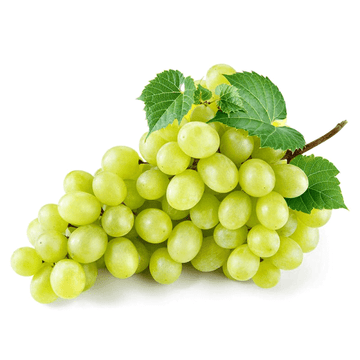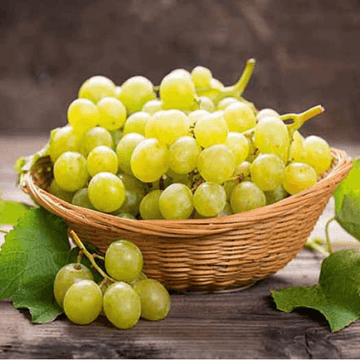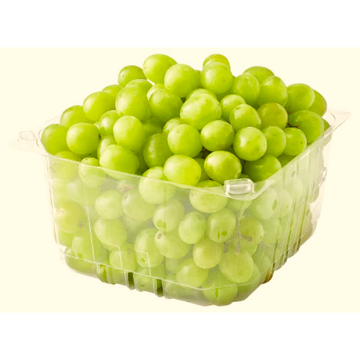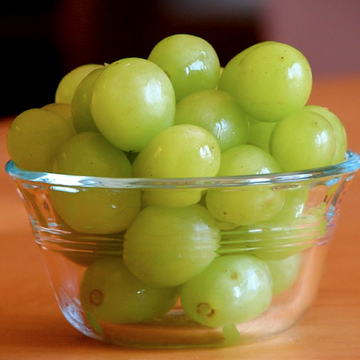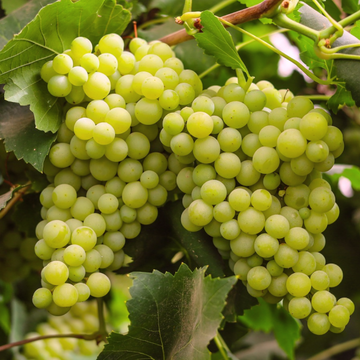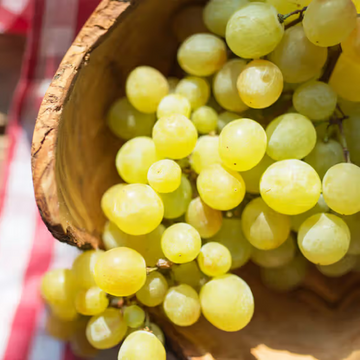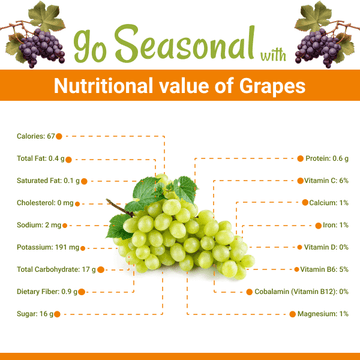
4.8/5
Based on 10,000+Happy Customers
Buy Grapes(انگور) - 1kg
- Home
- Buy Grapes(انگور) - 1kg
Best Offers: 1kg
Quantity:

Cash On Delivery
Easy Return & Refund Policy
24/7 Customer Support
The Middle East is generally described as the homeland of grapes and the cultivation of this plant began there 6,000–8,000 years ago. Yeast, one of the earliest domesticated microorganisms, occurs naturally on the skins of grapes, leading to the discovery of alcoholic drinks such as wine. The earliest archeological evidence for a dominant position of wine-making in human culture dates from 8,000 years ago in Georgia
The Middle East is generally described as the homeland of grapes and the cultivation of this plant began there 6,000–8,000 years ago. Yeast, one of the earliest domesticated microorganisms, occurs naturally on the skins of grapes, leading to the discovery of alcoholic drinks such as wine. The earliest archeological evidence for a dominant position of wine-making in human culture dates from 8,000 years ago in Georgia...
The oldest known winery was found in Armenia, dating to around 4000 BC. By the 9th century AD, the city of Shiraz was known to produce some of the finest wines in the Middle East. Thus it has been proposed that Syrah red wine is named after Shiraz, a city in Persia where the grape was used to make Shirazi wine.
Ancient Egyptian hieroglyphics record the cultivation of purple grapes, and history attests to the ancient Greeks, Cypriots, Phoenicians, and Romans growing purple grapes both for eating and wine production. The growing of grapes would later spread to other regions in Europe, as well as North Africa, and eventually in North America.
In 2005, a team of archaeologists concluded that some Chalcolithic wine jars, which were discovered in Cyprus in the 1930s, were the oldest of their kind in the world, dating back to 3,500 BC. Moreover, Commandaria, a sweet dessert wine from Cyprus, is the oldest manufactured wine in the world, its origins traced as far back as 2000 BC.
In North America, native grapes belonging to various species of the genus Vitis proliferate in the wild across the continent, and were a part of the diet of many Native Americans, but were considered by early European colonists to be unsuitable for wine. In the 19th century, Ephraim Bull of Concord, Massachusetts, cultivated seeds from wild Vitis labrusca vines to create the Concord grape which would become an important agricultural crop in the United States.
Benefits:
Rich in Nutrients: Packed with vitamins C and K, potassium, and antioxidants.
Heart Health: May lower blood pressure and reduce cholesterol levels.
Anti-Inflammatory: Contains antioxidants that reduce inflammation.
Digestive Health: High water content and fiber support digestion.
Boosts Immunity: Vitamin C strengthens the immune system.
Eye Health: Contains compounds that support vision.
May Aid Weight Loss: Low in calories and high in water content.
Hydration: High water content helps maintain hydration.
Uses of grapes:
Culinary Uses: Enjoy fresh grapes as a healthy snack or add them to fruit salads and cheese platters.
Beverages: Use grapes to make grape juice, smoothies, or wine for a refreshing drink.
Baking: Incorporate grapes into baked goods like muffins, cakes, and bread for added sweetness and moisture.
Salads: Add grapes to green or chicken salads for a burst of flavor and texture.
Cooking: Use grapes in savory dishes, such as roasted meats, stews, and sauces, for a sweet contrast.
Dried Grapes (Raisins): Dried grapes, or raisins, are popular in cereals, trail mixes, and baking.
Jams and Jellies: Cook grapes to make delicious jams and jellies that can be spread on toast or used in recipes.
Frozen Grapes: Freeze grapes for a refreshing, bite-sized treat, especially in hot weather.
Infused Water: Add grapes to water or iced tea for a naturally sweet and flavorful infusion.
Skincare: Grape seed extract and oil are used in skincare products for their antioxidant and moisturizing properties.
Nutritional components per 100 grams:
- Calories: 67
- Total Fat: 0.4 g
- Saturated Fat: 0.1 g
- Cholesterol: 0 mg
- Sodium: 2 mg
- Potassium: 191 mg
- Total Carbohydrate: 17 g
- Dietary Fiber: 0.9 g
- Sugar: 16 g
- Protein: 0.6 g
- Vitamin C: 6%
- Calcium: 1%
- Iron: 1%
- Vitamin D: 0%
- Vitamin B6: 5%
- Cobalamin (Vitamin B12): 0%
- Magnesium: 1%





Milk is a versatile and nutrient-rich beverage that has been consumed by humans for thousands of years. Derived primarily from cows, but also from goats, sheep, and other mammals, milk is renowned for its creamy...





The date palm is dioecious, having separate male and female plants. They can be easily grown from seed, but only 50% of seedlings will be female and hence fruit-bearing, and plant dates are often smaller...





The date palm is dioecious, having separate male and female plants. They can be easily grown from seed, but only 50% of seedlings will be female and hence fruit-bearing, and plant dates are often smaller...





Bananas are among the most important food crops on the planet. They come from a family of plants called Musa that are native to Southeast Asia and grown in many of the warmer areas of...





Pomegranates (Punica granatum) have a storied history dating back millennia, originating in regions of modern-day Iran and spreading throughout ancient civilizations. Revered in mythology and religious texts for symbolizing fertility and abundance, pomegranates were buried...





Pomegranates (Punica granatum) have a storied history dating back millennia, originating in regions of modern-day Iran and spreading throughout ancient civilizations. Revered in mythology and religious texts for symbolizing fertility and abundance, pomegranates were buried...





The blood orange is a natural mutation of the orange, which is itself a hybrid, probably between the pomelo and the tangerine. Within Europe, the arancia rossa di Sicilia (red-orange of Sicily) has Protected Geographical...





Musami, also known as sweet lime or mosambi, is believed to have originated in Southeast Asia, particularly in India. It is a citrus fruit, and its cultivation spread to various tropical and subtropical regions due...





The apple is thought to have been domesticated 4,000–10,000 years ago in the Tian Shan mountains, and then to have travelled along the Silk Road to Europe, with hybridization and introgression of wild crabapples from...





Ambri is the only variety indigenous to our subcontinent. It grows in Kashmir and is one of its most closely guarded secrets... The apple is thought to have been domesticated 4,000–10,000 years ago in the Tian...





The apple is thought to have been domesticated 4,000–10,000 years ago in the Tian Shan mountains, and then to have travelled along the Silk Road to Europe, with hybridization and introgression of wild crabapples from...





The apple is thought to have been domesticated 4,000–10,000 years ago in the Tian Shan mountains, and then to have travelled along the Silk Road to Europe, with hybridization and introgression of wild crabapples from...





The avocado, alligator pear, or avocado pear (Persea americana) is a medium-sized, evergreen tree in the laurel family (Lauraceae). It is native to the Americas and was first domesticated in Mesoamerica more than 5,000 years...





Elizabeth White: The Woman Who Invented the Blueberry | New Jersey: Then and Now. By 1916, Elizabeth White and Dr. Fredrerick Coville, USDA Botanist, had cultivated the first batch of domesticated blueberries. This clip explains...





A pitaya (/pɪˈtaɪ.ə/) or pitahaya (/ˌpɪtəˈhaɪ.ə/) is the fruit of several different cactus species indigenous to the region of southern Mexico and along the Pacific coasts of Costa Rica, El Salvador, Guatemala and Nicaragua. Pitaya...





Cabbage is one of the oldest cultivated vegetables, with origins dating back over 2,000 years. It is believed to have been grown in ancient civilizations such as the Greeks and Romans. The earliest records of...





The Middle East is generally described as the homeland of grapes and the cultivation of this plant began there 6,000–8,000 years ago. Yeast, one of the earliest domesticated microorganisms, occurs naturally on the skins of...





Turnips (Brassica rapa) have a long history that dates back thousands of years. They were first cultivated in the Mediterranean region, and evidence suggests they were being grown by the Greeks and Romans around 2000...





The blackberry is an edible fruit produced by many species in the genus Rubus in the family Rosaceae, hybrids among these species within the subgenus Rubus, and hybrids between the subgenera Rubus and Idaeobatus. The...





The first garden strawberry was grown in Brittany, France, during the late 18th century. Before this, wild strawberries and cultivated selections from wild strawberry species were the common source of the fruit. The strawberry fruit...





Shakarkandi, commonly known as sugarcane Saccharum officinarum, is a tall, perennial grass native to Southeast Asia and the South Pacific. It has been cultivated for thousands of years, with evidence of its use dating back...





Guavas originated from an area thought to extend from Mexico, Central America or northern South America throughout the Caribbean region. Archaeological sites in Peru yielded evidence of guava cultivation as early as 2500 BC... Guava...





Beetroot, also known as beet, has a long and storied history. It is believed to have originated in the Mediterranean region and was initially cultivated for its leaves rather than its roots. Ancient civilizations such...





Grapes are a type of fruit that grows in clusters of 15 to 300 and can be crimson, black, dark blue, yellow, green, orange, and pink. "White" grapes are green in color and are evolutionarily...





Peas (Pisum sativum) have been cultivated for thousands of years and are among the earliest domesticated crops. Evidence suggests that peas were grown in the Middle East as early as 7000-8000 BCE. They were an...





Grapes are a type of fruit that grows in clusters of 15 to 300 and can be crimson, black, dark blue, yellow, green, orange, and pink. "White" grapes are green in color and are evolutionarily...





Cauliflower has a long history that dates back to ancient times. It is believed to have originated in the Mediterranean region, where it was cultivated by the Romans and Greeks. It was known in the...





Radishes (Raphanus sativus) have been cultivated for thousands of years. They are believed to have originated in Southeast Asia, with evidence of their cultivation dating back to ancient Egypt and Greece. The Greeks and Romans...





Carrots have a long history dating back over 5,000 years. Originally cultivated in Persia (modern-day Iran and Afghanistan), they were first used for their leaves and seeds rather than their roots. The first cultivated carrots...





Spinach is a leafy green vegetable that has been cultivated for thousands of years. It is believed to have originated in Persia (modern-day Iran) and was first cultivated in ancient Persia and Mesopotamia. Spinach was...





The pumpkin (Cucurbita pepo) has a history that stretches back thousands of years. Native to North America, pumpkins were cultivated by Indigenous peoples as early as 7,500 to 5,000 BC. Early Native American tribes used...





Karela- also known as Bitter Gourd and Momordica Charantia. It is a vine plant that gives a nutritional green vegetable.It is a healthy vegetable in the world that has been used in many health problems...





Chickens are relatively large birds, active by day. The body is round, the legs are unfeathered in most breeds, and the wings are short. Wild junglefowl can fly; chickens and their flight muscles are too...





Chickens are relatively large birds, active by day. The body is round, the legs are unfeathered in most breeds, and the wings are short. Wild junglefowl can fly; chickens and their flight muscles are too...





Chickens are relatively large birds, active by day. The body is round, the legs are unfeathered in most breeds, and the wings are short. Wild junglefowl can fly; chickens and their flight muscles are too...





Chickens are relatively large birds, active by day. The body is round, the legs are unfeathered in most breeds, and the wings are short. Wild junglefowl can fly; chickens and their flight muscles are too...





Capsicum, commonly known as bell pepper, has a long and fascinating history. Native to the Americas, it was cultivated by indigenous peoples long before the arrival of Europeans. Christopher Columbus encountered capsicum during his voyages...





Ginger (Zingiber officinale) is a flowering plant whose rhizome, ginger root, or ginger, is widely used as a spice and a folk medicine. It is believed to have originated in the tropical rainforests of the...





Garlic (Allium sativum) is one of the oldest cultivated plants in the world. Its origins trace back over 5,000 years to Central Asia, specifically around the regions of modern-day Iran and Turkmenistan. It spread quickly...





Chili peppers are believed to have been first cultivated by the ancient civilizations in Central and South America, including the Aztecs, Incas, and Mayans, as early as 7,000 BCE. Christopher Columbus encountered chili peppers in...







































































































